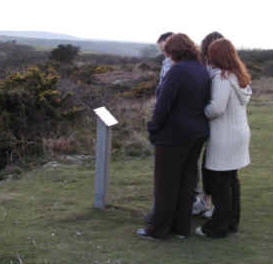
The Memorial

We have tried to tell the story of the loss of Zulu Bravo, what may -
With over 120 people at the memorial dedication, it was obvious that this event had gone deep into the consciousness of those living on the Island at the time, while the arrival of colleagues of the crew from the other side of the country showed that their loss was still keenly felt. At a time when trauma counseling had not been invented, these people had to come to terms with their experience without any help or external assistance. It has not been easy.

Channel Airways uniform badge -
As we spoke to people who came to the service of dedication, the true extent of this
hidden aspect of the tragedy became clear. A number of rescuers, both in the emergency
services and civilians were very badly affected, and continue to be so to this day.
Indeed one rescuer took his own life, unable to come to terms with what he had seen,
while other witnesses and helpers had serious mental problems and live with the memories
to this day. The fact that the wreckage -
After the service we held a traditional English tea for those involved, at nearby St Lawrence village hall . It was extremely concerning to hear people who were involved, or who had merely seen the aftermath of the incident 41 years before, recalling aspects of it as if it had happened that morning. This is a side of many accidents that is swiftly forgotten and while it does nothing to lessen the distress and suffering of those who were directly involved, we need to remember the others who were there on the Down at, or shortly after the crash. Everyone who had contact with this dreadful business suffered to a greater or lesser degree and everyone from friends of airline staff to passengers has their own story. This site is for them all.
The memorial plinth and column now stand on St Boniface Down, the highest point of the Isle of Wight. It is not a large structure, and it does not stand out, it was never intended to, but it is there, and anyone passing by or walking along the path to the crash site can pause for a moment to read the plaque, look out towards the Channel Islands and reflect on what happened that day long ago. It is now known locally as the 'Dakota Memorial' and a meeting place for walkers and ramblers.
The memorial is for everyone who was touched by the accident; survivors, friends,
families, colleagues, rescuers and helpers, and of course the crew and passengers
aboard Zulu Bravo who took off on 6th May 1962, on a lovely Sunny afternoon in the
Channel Islands -
They are not forgotten.

It was an accident. It was also a tragedy, but it was still an accident.
Thank you to the various enthusiasts who have sent us Channel Airways information
and illustrations for the site. All material remains copyright of the original owner.
If we have used an image without permission please contact us and we will remove,
credit it or give you a link. However we hope that use of these images will be accepted
in good faith -
Channel was a wonderful operation and still has a great following. In terms of safety it must have one of the best ratings of any transport operation in history. We would be pleased to receive photographs or memories that can be added to the site or privately to our growing collection of memories as and when time permits.


G-
Possibly the last photograph of ZB -
| Instruments |
| Visibility |
| Navigation |
| An Alternative Theory |
| Pressure On Crews |
| Blame |